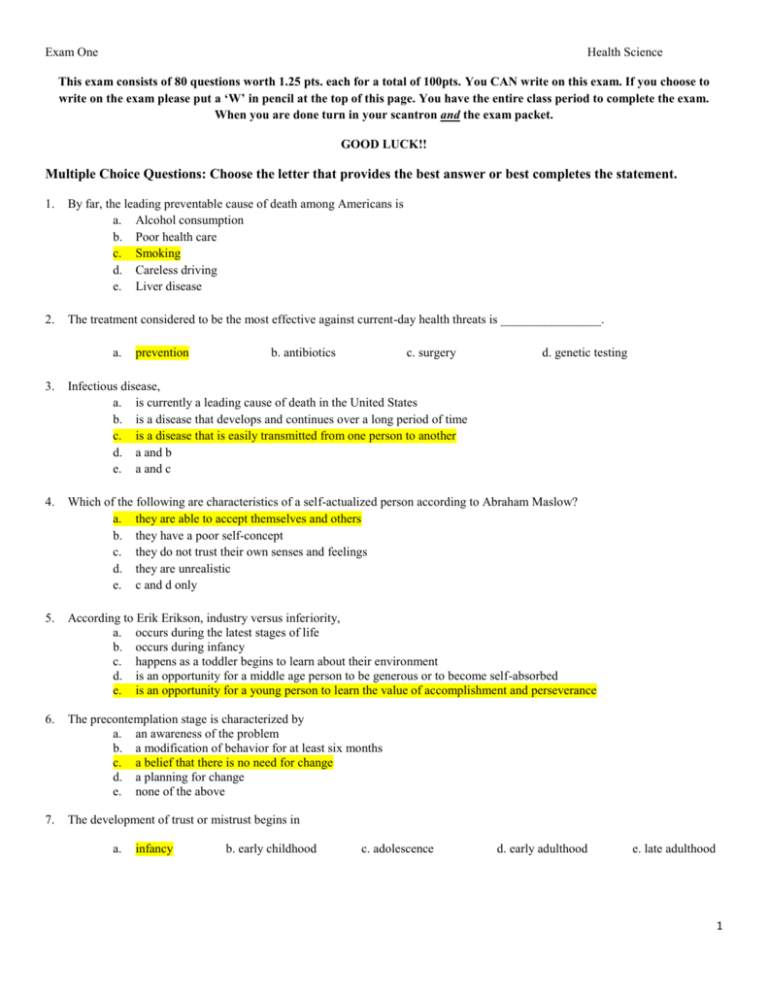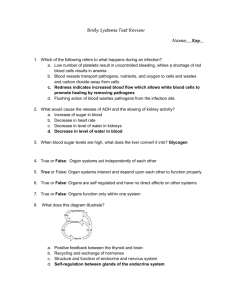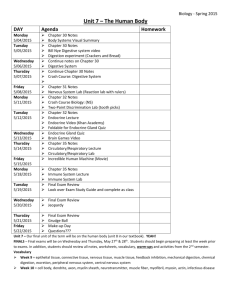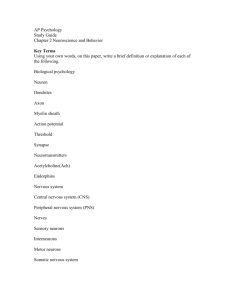Exam One Health Science This exam consists of 80 questions worth
advertisement

Exam One Health Science This exam consists of 80 questions worth 1.25 pts. each for a total of 100pts. You CAN write on this exam. If you choose to write on the exam please put a ‘W’ in pencil at the top of this page. You have the entire class period to complete the exam. When you are done turn in your scantron and the exam packet. GOOD LUCK!! Multiple Choice Questions: Choose the letter that provides the best answer or best completes the statement. 1. By far, the leading preventable cause of death among Americans is a. Alcohol consumption b. Poor health care c. Smoking d. Careless driving e. Liver disease 2. The treatment considered to be the most effective against current-day health threats is ________________. a. prevention b. antibiotics c. surgery d. genetic testing 3. Infectious disease, a. is currently a leading cause of death in the United States b. is a disease that develops and continues over a long period of time c. is a disease that is easily transmitted from one person to another d. a and b e. a and c 4. Which of the following are characteristics of a self-actualized person according to Abraham Maslow? a. they are able to accept themselves and others b. they have a poor self-concept c. they do not trust their own senses and feelings d. they are unrealistic e. c and d only 5. According to Erik Erikson, industry versus inferiority, a. occurs during the latest stages of life b. occurs during infancy c. happens as a toddler begins to learn about their environment d. is an opportunity for a middle age person to be generous or to become self-absorbed e. is an opportunity for a young person to learn the value of accomplishment and perseverance 6. The precontemplation stage is characterized by a. an awareness of the problem b. a modification of behavior for at least six months c. a belief that there is no need for change d. a planning for change e. none of the above 7. The development of trust or mistrust begins in a. infancy b. early childhood c. adolescence d. early adulthood e. late adulthood 1 Exam One Health Science 8. Psychological disorders may be a result of all of the following EXCEPT a. genetic differences b. chemical imbalances in the brain c. exposure to traumatic events d. good coping skills e. life events 9. The health determinant over which we have LEAST control is a. diet b. exercise c. tobacco use d. genetic makeup 10. The complete set of genetic material in an individual’s cells is referred to as her or his_________. a. genes b. genome c. proteome d. RNA e. none of the above 11. Adam’s parents are not unduly concerned about their son’s ability to adapt to college because he has always had a good sense of humor, been curious, and demonstrated openness to ideas. These qualities are reflective of Adam’s _______________ wellness. a. social b. spiritual c. intellectual d. emotional e. environmental 12. Spiritual wellness is best described as having a. a strong support network of family and friends b. a set of guidelines or beliefs c. the ability to express oneself creatively d. the ability to share one’s feelings e. none of the above 13. A target behavior can best be defined as a. several bad habits in need of change b. a lifelong habit you want to stop immediately c. an isolated behavior that is the focus of your behavior change program d. predisposed behavior e. a friends behavior that you urge him/her to change 14. An example of compulsion is a. the impulse to hurt a family member b. anxiety about contracting HIV infection from a sneeze c. uncontrollable worry about an accident d. constantly turning the lights on and off when entering a room e. none of the above 15. A controversial treatment for severe depression when all other approaches fail is, a. psychoanalysis b. drug therapy c. electroconvulsive therapy d. electroconvulsive therapy e. none of the above 16. Which of the following models of human nature and therapeutic change focuses on the brain and the use of pharmaceuticals for treatment? a. biological b. behavioral c. cognitive d. psychodynamic e. none of the above 2 Exam One Health Science 17. Which one of the following is a stressor? a. bad grade b. sweaty palms c. rapid pulse d. high fever e. fast heart rate 18. Mohammed just received an F on his term paper. Which type of stress is he likely to experience? a. eustress b. malstress 19. _____________ is an effective way of coping with stress. a. Tobacco use b. Drug use c. distress c. Time Management d. unmanaged stress d. Procrastination e. Getting angry 20. According to the General Adaptation Syndrome model, general exhaustion can result when a. the fight-or-flight reaction is resolved b. stress –related hormones are released c. distress occurs d. eustress occurs e. a stressor persists over a long period of time 21. The long-term wear and tear of the stress response has been termed_____________________. a. eustress b. distress c. homeostasis d. the allostatic load e. unmanaged stress 22. Which one of the following has been linked to a high allostatic load? a. obesity b. hypertension c. reduced immune function d. heart disease e. all of these choices are correct 23. Which two systems in the body work together to allow you to respond to stress? a. nervous and cardiovascular system b. cardiovascular and endocrine system c. endocrine system and nervous system d. endocrine and respiratory system e. urinary and digestive system 24. Carey would like to use meditation to help her manage her stress. Which of the following is likely to happen as a result of her use of this technique? a. it will help her tune out the world, temporarily removing sources of stress. b. it will help her rehearse upcoming events so that stress in her life will be reduced. c. it will help her to analyze the stressors in her life more effectively. d. it will help her visualize her tasks that need to be completely in a more efficient way. e. none of the above 25. Progressive relaxation techniques a. involve tensing and then relaxing the muscles in your body b. increase heart rate c. involve a lot of imagination and willpower d. can be quite complex and difficult to master e. none of the above 3 Exam One Health Science 26. Biofeedback helps people reduce stress by a. removing internal and external stressors b. cleaning the body of toxins c. increasing muscle strength and flexibility d. using imagery to visualize a relaxing place/person e. enabling them to become more aware of their levels of physical arousals 27. The system of glands, tissues and cells that helps control body functions by releasing hormones is the ____________ system. a. central nervous b. endocrine c. reproductive d. digestive e. cardiovascular 28. All of the following statements regarding the endocrine system are true EXCEPT a. The endocrine system is a system of glands and tissues that secrete hormones b. The endocrine system includes organs such as the pancreas and adrenal glands c. During a physical stress response, the endocrine system causes the release of adrenaline d. The endocrine system mainly works through nerves that extend out from the brain to other regions of the body such as muscles e. The endocrine system is involved in the fight-or-flight response 29. Which component of the nervous system is responsible for integrating and interpreting information coming from the internal and external environment of the body? a. neurons b. brain c. neuron cell body d. nerves e. spinal cord 30. During the stress response, the adrenal glands release a. adrenocorticotropic hormone (ACTH) b. adrenaline c. endorphins d. norepinephrine e. glucose 31. The branch of the autonomic nervous system that is activated when a person is exposed to a stressor is the ___________________ nervous system. a. central b. somatic c. parasympathetic d. sympathetic 32. The somatic nervous system manages a. actions under conscious control (voluntary movements) b. heart rate c. the fight-or-flight reaction to a stressor d. hormones released in response to a stressor e. digestion 33. The parasympathetic branch of the autonomic nervous system a. is responsible for mobilizing energy sources for use in a crisis b. activates the endocrine system c. is in control when one is frightened or angry d. helps in digestion and growth during resting periods e. none of the above 4 Exam One Health Science 34. The way in which an individual responds to stress is influenced by a. biological predispositions b. past experiences c. current circumstances d. biological predispositions and past experiences e. all of these influence the way an individual response to stress 35. Which one of the following events DOES NOT occur during a physical response to stress? a. a heightened sense of touch/feeling b. visual acuity increases c. your blood pressure increases d. skeletal muscles contract faster e. the bronchi of the lungs dilate 36. In the theory of stress and disease called the generalized adaptation syndrome, the ________ stage is characterized by a sequence of events that are brought on by the activities of the sympathetic nervous system. a. alarm b. resistance c. divergent d. exhaustion e. plateau 37. Psychoneuroimmunology (PNI) is the study of the interaction between all of the following systems EXCEPT the a. nervous b. endocrine c. respiratory d. immune e. none of the above 38. Homeostasis is, a. how your body’s internal environment doesn’t change b. when your body does not change relative to the external environment. c. the body’s ability to keep an internal stable environment even thought the external environment is always changing. d. when your body becomes excited during a stress response. e. the exhaustion one may feel after dealing with stress for a long period of time. 39. A social phobia is the fear of __________. a. animals b. high places c. heights d. seeing blood e. embarrassment/humiliation 40. Which of the following is a characteristic of depression? a. Trouble concentrating b. Autonomy c. Obsession with exercise d. Increased social interaction e. None of the above 41. All of the following terms are used in the behaviorist’s analysis of behavioral dysfunction, EXCEPT a. reinforcement b. intervention c. stimulus d. response 42. The technique of exposure therapy is used to a. encourage people to face their fears b. discourage people from encountering their fears c. promote avoidance of the feared situation d. introduce the patient to other frightening situations e. none of the above 5 Exam One Health Science 43. All of the following statements regarding suicide are true EXCEPT: a. White men over 65 have the highest rate of suicide. b. Women attempt suicide 3 times more than men do. c. Men are 3 times more likely to be successful at committing suicide than women are. d. Most people that commit suicide have expressed the wish to be dead. e. Most people that commit suicide tend to surround themselves with friends and family to gain positive support. 44. Sandra has had a cough for 3 weeks. Which of the following is likely to be her best option for addressing this symptom? a. waiting an additional 2 weeks to see if her condition improves b. self-treatment c. observing her symptoms d. checking with a physician e. none of the above 45. Joan’s doctor has recommended she have heart surgery. Which of the following would be an important question she should ask her doctor? a. What can I expect before, during and after the surgery? b. Why do I need surgery at this time? c. What are the risks and complications associated with the surgery? d. Are there any alternative forms of medicine that I should consider to avoid having surgery? e. All of these choices are important questions to ask. 46. A person should check with a physician about symptoms with any of the following characteristics EXCEPT symptoms that are a. recurrent b. familiar c. persistent d. severe 47. Which of the following is needed to effectively manage one’s medical problems? a. you need to learn how to be a good observer and assess your symptoms b. you need to be able to decide when to seek professional advice c. you need to know how to safely self-treat common medical issues d. you need to learn how to choose a medical professional if the need arises e. all of the choices are needed 48. Ramon has been stung by a bee and is now becoming short of breath. Which of the following is likely to be the best strategy for dealing with Ramon’s symptom? a. waiting an hour to see if his condition improves b. self-treatment with over-the-counter pain medication c. calling a physician’s office for advice d. going to an emergency room e. none of the above 49. Self-assessment of medical symptoms begins with a. Purchase of over-the-counter drugs b. Self medicating c. Observation of your symptoms d. Medical self-tests e. Phone call to the doctor 6 Exam One Health Science 50. Western medicine traditionally relies on the use of ___________ to treat and cure diseases. a. phytochemicals b. antioxidants c. isoflavins d. pharmaceuticals e. all of the above 51. Homeopathy is an example of a(n) a. mind-body intervention b. alternative medical system c. biological-based therapy d. energy therapy e. manipulative and body-based methods 52. Herbal remedies are central to which of the following domains of complementary and alternative medicine? a. mind-body interventions b. alternative medical systems c. biological-based therapies d. energy therapies e. manipulative therapies 53. Which one of the following is considered a mind-body intervention? a. yoga b. visualization c. prayer d. hypnosis e. all of these choices are considered mind-body interventions 54. Western researchers might explain the effects of acupuncture as being the result of a. correction of the flow of qi b. rebalancing of yin and yang c. release of hormones and neurotransmitters d. restoration of equilibrium e. none of the above 55. Which of the following is a primary treatment method used in traditional Chinese medicine? a. massage b. herbal remedies c. chiropractic d. surgery e. pharmaceuticals True/False Questions. If any portion of the statement is false then the entire statement is false. A= True B = False 56. The fight-or-flight response prepares the body for physical action regardless of whether action is needed. (T/F) 57. Endorphins are body-produced chemicals that relieve pain and are produced during exercise. (T/F) 58. Being normal is an accurate definition of psychological health.(T/F) 59. Therapies for anxiety disorders concentrate primarily on diet and exercise. (T/F) 60. The parasympathetic and sympathetic nervous system are branches of the autonomic (involuntary) nervous system. (T/F) 7 Exam One Health Science 61. Organs such as the adrenal glands, pancreas and pituitary gland are components of the endocrine system. (T/F) 62. Knowledge about health is all you need to undertake a behavior change. (T/F) 63. Social support is not important for motivation during a behavior change program. (T/F) 64. Despite their growing popularity many conventional and alternative medicine practices remain controversial and individuals need to be critically aware of safety issues. (T/F) 65. A person with type C personality is more likely to respond to a stressor by suppressing his/her feelings. (T/F) 66. The way in which you breathe is an important part of relaxation because the body associates the rate of ventilation with stress level. (T/F) 67. Hypnosis is a therapy offered only by western medical professionals. (T/F) 68. The fight-or-flight reaction occurs during the exhaustion stage of the general adaptation syndrome. (T/F) 69. There is a link between cardiovascular heart disease and stress. (T/F) Matching. Match the terms on the right with the description/ definition on the left. 70. A disorder characterized by restlessness and high energy levels_____ a. panic disorder 71. A disorder that is characterized by extreme anxiousness about future events_____ b. mania 72. Disorganized thoughts, delusions and hallucinations are characteristic of this disorder____ c. obsessive compulsive disorder 73. A disorder characterized by repetitive difficult to resist thoughts and actions_____ d. generalized anxiety disorder 74. A disorder characterized by sudden and unexpected surges in anxiety_____ e. schizophrenia Read the statements below regarding the two opposing practices of Eastern and Western medicine. Use answer choices ‘a’ or ‘b’ to match the following descriptions with the health care practice it is associated with. a. Eastern Medicine b. Western Medicine 75. The belief that an identifiable factor such as a virus causes illness.____ 76. The belief that disease is defined by a defect of function or energy____ 77. Based on scientific ways of gaining knowledge like being rational, tentative and testable.____ 78. The belief that disease is caused by an imbalance of Qi.____ 79. The use of surgery and pharmaceuticals to treat disease.____ 80. The belief that good health is the lack of disease or pain.____ 8









